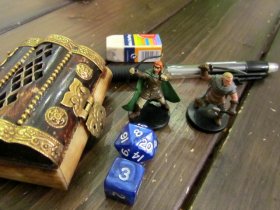When designing or running an adventure, you need to be careful about how you use details. While details can make a story alive, they can also make your players fall asleep. If at the end of a hectic chase the player characters enter the villain's headquarters, and gamemaster first describes the general mood with colourful words, then details the magnificent gate that is used for the entrance, the extremely detailed room after the the entrance, the villain's right hand you've designed so well and finally the villain himself, as well as his current lover, impressive throne and his harem, you're likely to have half your group dozing at the table.
Ballast of the old rpg design style
Roleplaying games and adventures are still suffering from some of the ballast of the old game design style. When our hobby was young, there was no actual design or development for adventure format. Many games still suffer from this ballast. Roleplaying games are books and they should look like books, right? I have another post pending about this topic, so no more about it this time.
Details can kill the mood - pacing to the rescue

While games can be built on details, you'll need to know when to use them. A bit more 'artistic' style of gaming might well work with multitude of details, but most gamers want their action hot. Even those that think that combat and action isn't the main thing in rpg's are likely to get upset if the dramatic moment in the game gets watered down by descriptions of the scene.
You can introduce details in paces. Create a scene where players arrive to the great scene and let them do something, let them meet the villain's right hand in the beginning of the adventure, and let them get a glance of the villain too before the end scene. This way you can concentrate on describing the final throne room and the special armor the villain is wearing with a few clauses.
Players have imagination - use archetypes, methaphors and resemblances
Why should you describe everything accurately? Your players have imagination! We all have imagined all those magnificent places and impressive characters in the books we have read, so let the imagination work for your players (and for you)! Throw some hooks for their imagination and you're good. You can bet your player can visualize the villain's harem well enough after a few descriptive words - or even without them.
'The king steps down the stairs in his majestic dress and short white beard, think of Sean Connery' works sometimes well. Even if you don't tell players that the character is a lot like Sean Connery, you may use the role model how you think of the character, and how you play him. 'It's pretty much like the village next to Hogwarts' works also well to describe a village.
Be careful when using actors, characters or other references, as they may make your players start joking or making references about the character! Sometimes it may be just funny, but it may also be a mood-killer.
Using photos
You want to show something to your players instead of trusting their imagination? No problem. You can show photos of existing locations resembling to one on your mind, or you can actually find inspiration from the photos you find. Kutna Hora -church in Czech for example is a great example, it's a church full of skulls - try google for it. Use google image search for gothic cathedral, spider web cavern or whatever you want to find.
Photos can also be a mood-killer, so be careful when using them.
***
I hope this article gave you something to think of, when designing adventures or running them. Do not spoil the tension with too much details, use just required amount of descriptions and tell more only if players really want so!